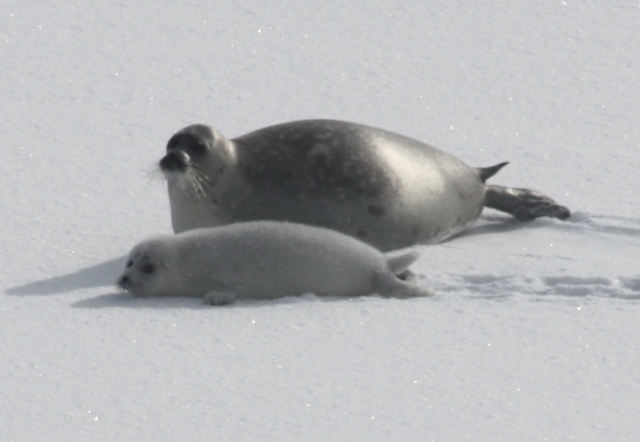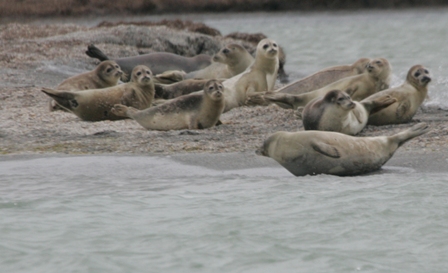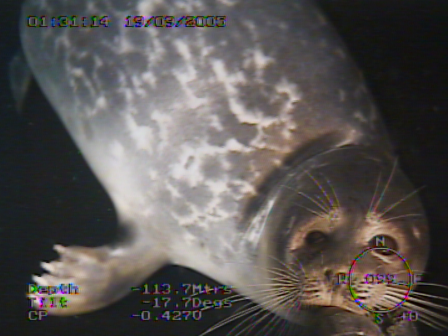Caspian Seal
(Pusa caspica)
IUCN STATUS (2010) - ENDANGERED
| Info Update: This species page has recently been updated (June-August 2011). More detailed information can be found at http://www.caspianseal.org/ | |
| Distribution and Numbers The Caspian seal is one of the smallest of the 'true' phocid seals and is found only in the Caspian Sea, a landlocked sea of about 393,000 km2 bordered by Russia, Azerbaijan, Iran, Turkmenistan and Kazakhstan. The seals originated from a Pusa (ringed seal) common ancestor, and will have - several million years ago - migrated freely between the Arctic Ocean and the Tethys Sea via open waterways. The Caspian Sea is a remnant of the former Tethys Sea, and the seals are thought to have become isolated there when the waterways from the Arctic ceased to exist about 1.3 million years ago (Fulton & Strobeck, 2010). Recent genetic studies have indicated that the Caspian seal's closest living relative is, amazingly, the very much larger Atlantic grey seal (Halichoerus grypus) (Palo and Väinöla, 2006). Caspian seals were at one time extremely numerous, with a population size estimated from hunting records to have been around 1,200,000 to 1,500,000 animals with annual pup births of 275,000 to 400,000 pups (Härkönen et al., in preparation). However, an estimate of breeding population size from systematic aerial surveys of the breeding ice in 2005 and 2006 found the number of up births to be around 21,000 and 17,000 respectively (Härkönen et al. 2008), and numbers of pups since then have varied between 7,000 and 15,000 (Härkönen et al. unpblished data). |
Photo: Caspian International Seal Survey |
| Status The Caspian seal's status in the IUCN Red List was changed from Vulnerable to Endangered in October 2008. The population decline over the past 150 years is directly related to intensive and unsustainable hunting, which has been ongoing since the mid-18th century, with tens of thousands of seals killed on the breeding grounds on the winter ice-field every year. Accurate hunting records began around 1867, with numbers of seals killed varying from about 30,000 to 110,000, about half of whch were pups. The annual kill fell around 1920 and then rose again to about 100,000 around 1940, and then fell to around 40,000 seals per year. From the 1960s the annual kill on the ice-field was limited to pups, and the reported kill fell steadily until the ed of the 20th century. Commercial hunting ceased briefly around 1996, and the sealing ships became rusting hulks in the Kazakhstan port of Fort Schevchenko. However, smaller-scale hunting resumed by Russian hunters c.2004. Russia leads a Caspian inter-governmental quango, the 'Aquatic Bioresources Commission' and - ignoring the IUCN 'Endangered' status and the results of the aerial surveys of the breeding population - continues to consider the Caspian seal to be a 'harvested species' and to issue 'quotas' of 18,000 seals, mainly to Russia and Kazakhstan, although in reality only Russian hunters kill a few thousand pups when they are able to find them. In addition to this 'legal' hunting in Russia, seals are killed on the ice illegally, and are also caught in fishing nets. It is currently estimated that about 12,000 seals are caught annually in large-mesh nets illegally set for sturgeon in the North Caspian (Dmitrieva et al., in preparation), and that by-catch (and sometimes deliberate catch) in fishing nets is now the single most serious factor in the continuing population decline. |
| In the spring of 1997 a mass mortality of sealswas reported along the coast of Azerbaijan. Post-mortem investigation of four carcasses by a World Bank team found extraordinarily high levels of DDT in the blubber of two of the dead seals, and an previously unknown strain of canine distemper virus (CDV) in the brain of an adult female (Forsyth e al.,1998). In April-June 2000 several thousand Caspian seals were found dead and dying along the Kazakhstan coast in the northeast Caspian Sea, further south in Turkmenistan, and also along the northwest and west Caspian Sea coasts of Russia and Azerbaijan. Reports of an increased mortality rate were received from the Iranian coast in October–December 2000, and then a further mass mortality occurred in sring 2001. Analysis has indicated that the primary cause of the mass mortality was again CDV, and indeed the same CDV strain as found in 1997 (Kennedy et al. 2000; Kuiken et al. 2006). Although the virus is thought to persist in the seal population, there has so far (to 2011) been no further large-scale mortality attributed to it. |
| It has been suggested that the apparent persistence of distemper-related high mortality in the species may have been exacerbated by the weakening of the seals' immune systems due to the high levels of DDT compounds and other organochlorine pollutants found in the seal carcases and in Caspian fish and (Kajiwara et al. 2008). However, re-analysis of all the 1997–2002 mortality data suggests that the CDV epidemic occurred independently of contaminant levels in the seals. Sub-acute distemper itself compromises the immune systems of infected seals, and would have had a much greater impact than pre-existing contaminant levels. Furhermore, many of the seals that died of CDV were young juveniles, with low contaminant levels (Kuiken et al.,2006; Wilson, Eybatov et al. in preparation). |
| It has aso been sugested that pollution in the Caspian Sea may be affecting the reproductive success of females, with a high proportion of barren females being reported in the late 1980s and 1990s (Watanabe et al. 1999; Kajiwara et al. 2008). However, further analysis suggests many of these females may have been barren due to their advancing age, and that organochlorine contamination levels in the blubber, although high in a few adult males, are not generally as high as levels in the Baltic seals, where serious disease complexes and infertility have resulted (e.g. Helle et al. 1990). |
|
Photo: Caspian International Seal Survey |
Intensive commercial fishing by man of some of the prey species of the Caspian seal may have a serious effect on the seals' available food resources. Kilkas (Clupeonella sp.) are an important high-energy component of the seals' diet. Kilkas were highly abundant throughout the Caspian, but Kilka fishing has intensified in recent years by means of new mechanised techniques (Kosarev and Yablonskaya, 1994). Stocks of kilka and other small fish have been further reduced due to intensive predation on fish larvae and zooplankton by an alien comb jellyfish, Mnemiopsis leidyi, accidentally introduced in ships' ballast in the late 1990s (Ivanov et al., 2000). It is possible (although there is no hard evidence as yet) that the large annual fluctuations in the number of pups born in the past few years has been due to fluctuations in food availability for pregnant females, and that the recovery of the species may ultimately be limited by a collapse in stocks of fish which should constitute the main prey items for Caspian seals. |
| In conclusion, the Caspian seal population is currently reducing by at east 3–4% per year. A total population size of about 104,000 was estimated from the pup production figure of about 21,000 in 2005 (Härkönen et al. 2008). A hind-casting analysis of the population size backwards from this 2005 estimate in 2005 suggests the population numbered about 128,000 in 1989 (and not 360–400,000, as suggested by Krylov, 1990). Since then there must have been an annual mortality averaging about 25,000 seals of all ages for the total population to have declined at the observed average rate of about 1,600 seals per year. This will have been due primarily to hunting and fishing by-catch, as well as natural mortality and predation on pups by wolves and eagles. In the past 6 years, therefore, the population must have declined by at least 9,600, to no more - and probably less than - about 94,000 seals. Until and unless hunting, fisheries bycatch and over-fishing are reduced, the prognosis for recovery for the Caspian seal is poor. There is a Caspian Seal Conservation Action Plan (CSCAP) agreed in 2007 by all five Caspian countries, but the plan has yet to be implemented in practice. |
|
Life history and annual cycle The newborn pup has a long coat of white fur, which acts as a thermal insulator in the bitter wind and cold. If this coat becomes wet, it loses its insulating properties, and the young pup would rapidly freeze to death; young whitecoat pups are, in fact, behaviourally adapted to avoid the water, even though the mother and other adults will enter the water freely (Wilson, Trukhanova & Dolgova, in prep.). The mother enters the water and travels under the ice to feed during the nursing period, and while she is away, the pup remains alone on the ice, although often it is only a few metres from a neighbouring mother and pup (Wilson, Trukhanova & Dolgova, in prep.). Over the 3-5 weeks of nursing, the pup develops an insulating layer of blubber, and at around 3 weeks of age the white coat is moulted to reveal a silvery grey coat of short fur. At this stage, or even just before the white coat is moulted, pups are able to enter the water, although many may not actually do so until the ice begins to melt. When the ice melts, the pups must learn to feed independently on small live prey, such as shrimp, kilka and gobies. Breeding males appear to space out along the edges of polynia, and it is thought that each male is joined by a female (although observations during the late breeding period are vey sketchy), they form a pair, and mating probably takes place in the water. Body measurements have indicated that there is no significant difference in body length between adult males and females (Wilson et al., in preparation), and therefore it is likely that the mating system is based on one male and one female forming a mating pair, probably with no polygyny. Moulting takes place after the pups are weaned and the adult seals have mated. If the ice lasts well into late March, the moult may begin on the ice, but when the ice melts the breeding seals gather in enormous dense aggregations of several thousand seals. About two thirds of the entire breeding adults currently assemble in Komsomolets Bay on the eastern kazakh coast during late March and April. This is a wide bay, with water less than a metre deep in most places, and studded with reed-covered sandy islands. Another important moulting site in the North Caspian is an island sandbar in the Russian sector, Mala Zemchuzniya, although the numbers are much smaller than in Komsomolets bay. At the same time, other seals - mainly juveniles and non-breeding adults - also moult at other island sites in different parts of the Caspian, including islands off the Apsheron peninsula in Azerbaijan. Only the newly weaned pups do not participate in this moult (they will not moult again until they are a year old) and while their elders are moulting in late March and April, the pups are learning to feed on small live prey at foraging sites throughout the Caspian. |
|
After the moult all the seals disperse to foraging areas throughout the Caspian - some seals selecting shallow areas in the north Capian or coastal fringe areas, while others select deeper water, diving as much as 500m (Caspian International Seal Survey, unublished data). The Caspian seal is an opportunistic, primarily bottom feeder, feeding on species such as kilka, silverside, gobies and shrimp. In the past few years, collection of faeces from seal haul-out sites has revealed that a very high proportion of ther diet is made up of gobies, with very little kilka. The seals appear to haul out seldom in the post-moulting period, when they are undoubtedly feeding intensively to restore their depleted fat reserves and body condition. As the summer advances, however, haul-out groups of up to about 300 seals may be seen on haul-out sites throughout the entire Caspian.
|
Photo: Farid Gadirov |
Vital Statistics
The body weight of adult Caspian seals varies according to season. In the spring, immediately after the moult, the weights range from about 33 to 50kg (Goodman et al., in preparation). However, in the autumn, weights range from about 53 to 82kg, with female weights obviously depending on whether or not they are pregnant (Goodman et al., unpubished data). Adult body length usually varies about 105 to 142 cm, with both sexes equal (Goodman et al., unpublished data; Wilson, Eybatov et al., in preparation). Pups are normally born weighing about 5kg and measuring 64-79cm in length. Both males and females become sexually mature at 7–8 years of age. They can live up to about 50 years of age, although females stop becoming pregnant round about the age of 30 years (Hadjiev and Eybatov, 195).
Internet links
There is a dedicated Caspian seal website which gives more detailed information on Caspian seal research and monitoring. More information may also be found from the Caspian Environment Programme website.
A Caspian seal pup moves around, crying in the vcinity of a fixed oil installation ('D island') in the north-east Caspian (Kazakhstan). Note: this pup appears agitated and searching for its mother. In undisturbed situations pups usually seem to wait quietly for their mother to return from a fishing trip. The reason for this pup's distress is not clear. Perhaps its mother has been away for longer than usual.
References
The following list of references are the source of the species information above. The full reference for manuscripts still in preparation will be added when they are published.
Dmitrieva, L., Kondakov, A., Oleynikov, E., Kydyrmanov, A., Karamendin, K., Kasimbekov, Y, Baimukanov, M. Wilson, S. and Goodman, S.J. In preparation. By-catch in illegal fisheries is a major source of mortality for Caspian seals.
Forsyth, M.A., Kennedy, S., Wilson, S., Eybatov, T., Barrett, T. 1998. Canine distemper virus in a Caspian seal. Vet. Rec. 143: 662–664.
Fulton, T. L. & Strobeck, C. 2010 Multiple fossil calibrations, nuclear loci and mitochondrial genomes provide new insight into biogeography and divergence timing for true seals (Phocidae, Pinnipedia). J. Biogeog. 37, 814–829.
Hadjiev, D. B. & Eybatov, T. M. 1995 Morphologia zybnovo apparata lastonogix. ISBN S-8066-1881-1 (In Russian) “Dental morphology of Pinnipeds (comparative, age related, applied odonthology of the Caspian seal”. Baku, Elm, 173 pp.
Härkönen, T. 2008 Pusa caspica. In: IUCN Red List of Threatened Species. Version 2010.2. Available from http://www.iucnredlist.org/apps/redlist/details/41669/0/.
Härkönen, T., Jüssi, M., Baimukanov, M., Bignert, A., Dmitrieva, L., Kasimbekov, Y., Verevkin, M., Wilson, S. & Goodman, S. J. 2008 Pup production and breeding distribution of the Caspian seal (Phoca caspica) in relation to human impacts. Ambio 37, 356-361.
Helle, E., Stenman, O., Olsson, M., Helander B and Härkönen, T. 1990. Baltic seals: Population size, reproduction and organochlorines. Ambio special report, 7: 16–17.
Ivanov, V.P., Kamakin, A.M., Ushivstsev, V.B., Shiganova, T., Zhukova, O. Aladin, N. Wilson, S.C., Harbison, R. and Dumont, H.K. 2000. Invasion of the Caspian Sea by the comb jellyfish Mnemiopsis leidyi (Ctenophora). Biol. Inv., 2: 255–258.
Kajiwara, N., Watanabe, M., Wilson, S., Eybatov, T., Mitroaniv, I.V., Aubrey, D.G., Khuraskin, L.S., Miyazaki, N. & Tanabe, S. 208. Persistent organic pollutants (POPs) in Caspian seals of unusual mortality event during 2000 and 2001. Environ. Pollut., 117: 391–402.
Kennedy, S., Kuiken, T., Jepson, P. D., Deaville, R., Forsyth, M., Barrett, T4., van de Bildt, M.W.G., Osterhaus, A.M.D.E., Eybatov, T., Duck, C., et al. 2000 Mass die-off of Caspian seals caused by canine distemper virus. Emerg. Inf. Dis. 6, 637–639.
Kosarev, A.N. and Yablonskaya, E.A. 1994. The Caspian Sea. SPB Academic Publishing, The Hague. x+259pp.
Krylov, V. I. 1990 Ecology of the Caspian seal. Finn. Game Res. 47, 32–36.
Kuiken, T., Kennedy, S., Barrett, T., Borgsteede, F., Deaville, R., Duck, C., Eybatov, T., Forsyth, M., Foster, G., Jepson, P., et al. 2006 The 2000 canine distemper epidemic in Caspian seals (Phoca caspica): pathology and analysis of contributory factors. Veterinary Pathology 43, 321-338.
Palo, J. U. and Väinöla, R. 2006. The enigma of the land-locked Baikal and Caspian seals addressed through phylogeny of phocine mitochondrial sequences. Biol. J. Linn. Soc., 88: 61-72.
Watanabe, M, Tanabe, S., Tatsukawa, R., Amano, M, Miyazaki, N., Petrov, E.A. and Khuraskin, S.L. 1999. Contamination levels and specific accumulation of persistent organochlorines in the Caspian seal (Phoca caspica) from the Caspian Sea, Russia. Arch. Environ. Contam. Toxicol., 37:396–407.
Wilson, S.C., Eybatov, T.M., Amano, M., Asad, H., Barrett, T., Jepson, P.D. and Goodman, S.J. In preparation. Implications of contamination levels for immunity, fertility and disease epidemiology in Caspian seals, Phoca caspica.
Wilson, S.C., Trukhanova, I, and Dolgova, E. In preparation. Mother and pup behaviour of the Caspian seal, Phoca caspica.



